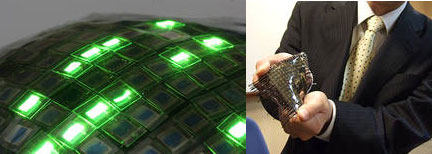Electrical engineering researchers at the University of Tokyo have developed a new type of OLED display technology that can be bent and stretched like rubber without incurring any damage. The material is reportedly produced by spraying a layer of carbon nanotubes with a fluoro-rubber compound, creating a display that can be stretched an additional 50% of its normal size and wrapped around complex 3D surfaces.

What's more, this is done through an industrial printing process that should make the technology inexpensive to boot. Prototypes are currently monochrome and have a resolution of just 256 pixels, but those responsible for the invention say they are now working on adding color and increasing resolution. Some potential uses mentioned for these new displays include moving or spherical objects and to show medical diagnosis data.
A significant benefit of OLED displays over traditional liquid crystal displays (LCDs) is that OLEDs do not require a backlight to function - thus they draw far less power and can be much thinner than an LCD panel. Serving as another example of what can be achieved with OLED technology, HP showed off late last year a flexible, paper-like display made almost entirely out of plastic.